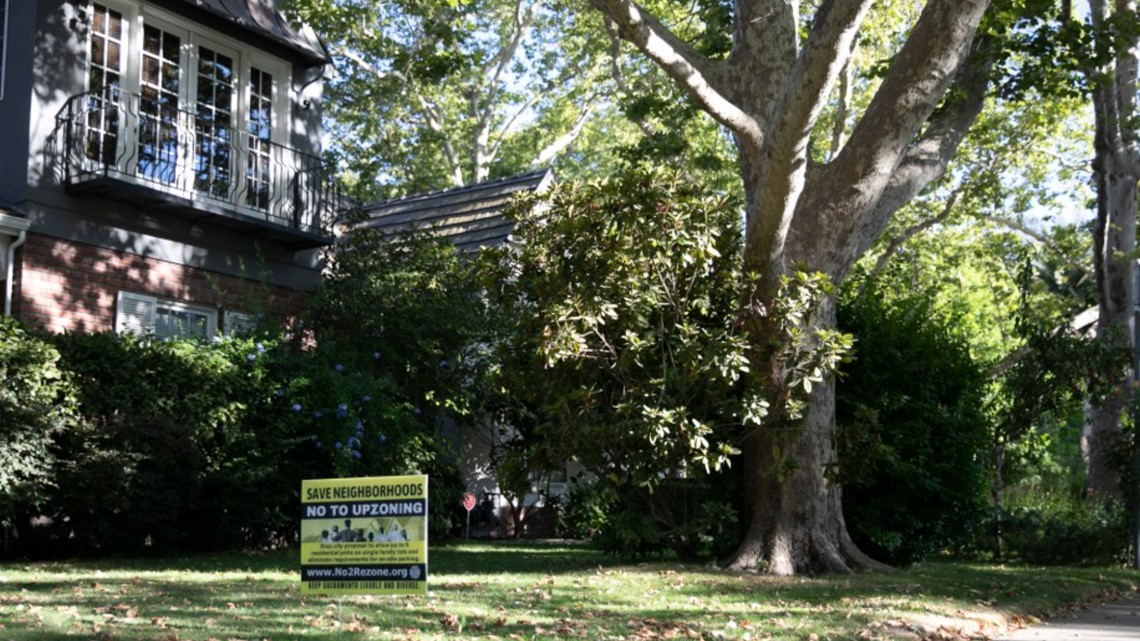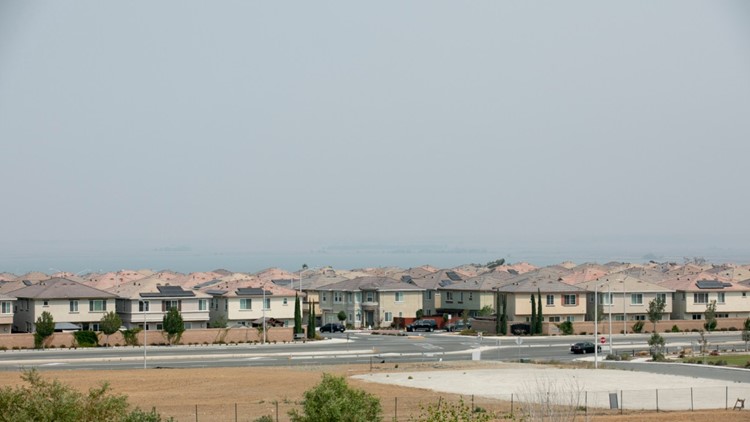CALIFORNIA, USA — This story was originally published by CalMatters.
The solution to California’s housing crisis is simple: Scrap the California Environmental Quality Act.
At least according to the major Republican candidates in the Sept. 14 recall election.
“I believe one of the reasons we have a homeless problem in California is because of laws like CEQA,” front runner Larry Elder told CalMatters during a recent interview.
John Cox, a Republican businessman also running to unseat Gov. Gavin Newsom, said he would work with the Legislature to make sure CEQA is “scaled down or eliminated.” Kevin Kiley, a state Assembly member from Rocklin, called CEQA “a huge part of the problem.”
Democrat and YouTube personality Kevin Paffrath said he, too, would reform CEQA.
CEQA is landmark legislation signed into law in 1970 by Republican Gov. Ronald Reagan. It requires public agencies to reduce or mitigate the environmental impacts of development wherever feasible. Essentially, the law tells developers to study a project to see how it could harm the environment and explain how they will lessen the damage. The law has been invoked by NIMBYs to block or delay multiple high-profile housing projects.
But is this law really the culprit behind the state’s housing woes, or just an easy target?
Overall, experts said CEQA is a huge headache for developers, and there are ample opportunities for reform. But getting rid of CEQA doesn’t get at the heart of the matter because it’s only one of many tools cities and local neighborhood groups use to block housing.
And the recall candidates have much less to say about those other tools because local control remains politically sacrosanct.
CEQA is “the boogeyman or the poster child for housing delays, but it’s an oversimplification of our challenges,” said Dan Dunmoyer, president and CEO of the California Building Industry Association. “It’s an important component of it, but there are many projects that we have a hard time getting to ‘yes’ that have not had CEQA pulled on them.”
A tool for NIMBYs or environmentalists?
In most other states, if a developer wants to build a project and it complies with the city’s general plan, they can go ahead.
But in California, even if land is zoned to allow the exact type of development proposed, a majority of projects must undergo a public hearing process that gives a platform to any neighbor or group to voice their concerns, explained Christopher Elmendorf, a law professor at UC Davis who focuses on land use.
CEQA is one of many tools a group can wield to raise those concerns. A developer has to review whether a project will have an adverse impact on a historical resource, or if the site is hazardous — and propose ways to mitigate those effects.
If a person or group, even anonymously, says those issues haven’t been adequately addressed, they can file a lawsuit — or multiple lawsuits, without a deadline, said Jennifer Hernandez, a San Francisco and Los Angeles-based attorney who often defends developers from CEQA litigation.
“CEQA lurks behind so many reasons we don’t have housing,” she said. “Instead of three months getting approval, we can spend 10 years in 39 public hearings, getting sued four times over.”
Still, there’s little data to quantify exactly how much time or money developers spend to bulletproof their projects against lawsuits, or to pay off interest groups. And there’s no real data to estimate how many projects are never proposed because of the threat of litigation.
But in studying existing lawsuits, Hernandez found in 2018 that 60% of CEQA lawsuits filed between 2010 and 2012 targeted residential housing developments, and the vast majority of them were urban infill developments, not projects in outlying areas. Other lawyers have contested these findings. She also found 64% of plaintiffs in CEQA lawsuits have no track record of environmental advocacy, showing, she says, that the law was being abused by unions and NIMBYs.
Still, supporters of CEQA argue it’s crucial in preserving existing housing stock, as well as protecting air and water. Ashley Werner, senior attorney with Leadership Counsel for Justice and Accountability in Fresno, has sued multiple industrial developments, including an Amazon warehouse, over the impact it could have on residents of the surrounding area.
Issues such as houses shaking when thousands of trucks roll by, dust from construction seeping into existing housing structures or worsening air pollution for mostly low-income communities of color near industrial developments would never be addressed if it weren’t for CEQA, she said. But when no one’s watching — as in many San Joaquin Valley developments, she argued — the law goes unused, and environmental damage happens.
Hernandez said she’s never called for getting rid of CEQA. She believes those filing lawsuits should be forced to disclose their identity and motivation; wants to eliminate duplicative lawsuits; and argues that CEQA should only apply to projects that truly harm the environment, public health or tribal resources.
The power of local control
While Hernandez has studied existing lawsuits at length, other researchers who looked at project approvals in general found most developments never reach the point of litigation.
In a 2016 review of CEQA lawsuits filed between 2013 and 2015, researchers for the environmental nonprofit Rose Foundation concluded that fewer than 1% of projects subject to environmental review — housing or not — faced lawsuits.


A more recent unpublished study found that fewer than 3% of 2,001 total projects with more than five housing units approved in 20 California jurisdictions between 2014 and 2017 were ever litigated. And only 30% of those lawsuits relied exclusively on CEQA, according to Moira O’Neill, senior research fellow at UC Berkeley’s Center for Law, Energy & the Environment; the majority of suits also argued violations of local land use law.
O’Neill and her colleagues also found the number of steps and time it took to get a project approved varied wildly between jurisdictions, even though CEQA applied to all of them. In Oakland, for example, projects took an average of five months to approve, compared to more than two years in San Francisco.
“By reforming CEQA you’re not solving the problem, because the biggest problem is local governments placing obstacles in the way of housing development,” O’Neill said.
Dunmoyer, from the California Building Industry Association, supports CEQA reform. But he said he’s had projects that took 15 years to approve that never encountered environmental litigation. A city council can demand a developer swap building materials or push a setback from 15 to 20 feet. Instead of having another hearing as soon as the changes are made, the council can delay the hearing for months or even years.
“There are other tools, just as simple as: ‘I don’t want any more houses here and the neighbors are lining up and committing to recall me and I want nothing to do with this,’” Dunmoyer said.
So how do you fix CEQA?
Attempts to change CEQA or even limit which projects it applies to are massive political undertakings. Just ask Newsom, former Gov. Jerry Brown or any state lawmaker. Even with a Democratic supermajority, bills that seek CEQA waivers struggle to even get out of policy committees in the Legislature.
One obstacle: labor unions, one of the most powerful interest groups at the Capitol, who can use litigation or the threat of it to get concessions such as requiring union workers to build the new development. Buy-in from the California State Building and Construction Trades was essential to pass a CEQA streamlining bill to build large housing projects with a minimum number of affordable housing units in 2017, for example.
So if elected, how would the recall candidates get anything done?
Even if they were to waive CEQA using an executive order, Dunmoyer said they’d be subject to litigation, fast. And when asked in CalMatters interviews about engaging the interest groups so effective at killing legislation, the candidates lacked a clear plan.
Elder said he would use his bully pulpit to take on special interest groups. Kiley said he would campaign against legislative opponents. And Paffrath said he would work with the Legislature to enact change.
The candidates have criticized Newsom for not making more progress toward his goal of adding 3.5 million housing units by 2025. Housing costs, they say, are forcing Californians to leave.
But besides killing CEQA, they have not proposed many solutions.
The candidates also said they supported shorter timelines for permitting approvals and slashing impact fees, which are levied to pay for a project’s infrastructure costs but vary widely across the state and can amount to 18% of a project’s total cost.
Assemblymember Tim Grayson, whose bill to bring more transparency and consistency to impact fees is now winding its way through the Legislature, said impact fees are just as important, if not more important than CEQA, in raising housing costs. But even his modest reform bill has taken years of collaboration.
“Did we get everything we wanted? No. That’s where politics came in. I think that’s how we make the soup here at the Capitol,” the Concord Democrat said.
When asked what they would do about local control, the recall candidates said they would leave it untouched. Cox said he would be open to applying a carrot, “maybe a stick, in the right circumstance.”
“I think the best decisions, whether it’s housing or anything else, is better done at the local level,” Elder said.
And what of local zoning, which often delays housing projects?
In a recent debate, Kiley, Cox and former San Diego Mayor Kevin Faulconer agreed they would not sign any bills to increase density on single-family zoned land.
Instead, most of the candidates proposed developing land outside of major cities, which is often blocked by the government‐established boundaries that separate urban areas from rural land, according to a recent CATO Institute study on housing affordability.
Paffrath proposed “the development of new communities, master-plan style communities outside of our large cities. So that way we’re not going into Santa Monica and trying to infill a ton of new housing.” To counter the environmental harms of urban sprawl, he also proposed building solar or wind farms.
But David Garcia, policy director for UC Berkeley’s Terner Center, called it hypocritical to use CEQA as a punching bag without a clear plan to tackle some of the most powerful interest groups that often block housing legislation and production.
“I think it’s a bit of a red herring,” Garcia said. “If you get rid of CEQA, that doesn’t mean much new housing is going to get built because they’re not for zoning reform, they’re not for any of these other things that we’ve identified are important to spur housing development.”
WATCH RELATED: CA recall election: Secretary of State discusses election security procedures (Sep 6, 2021)



